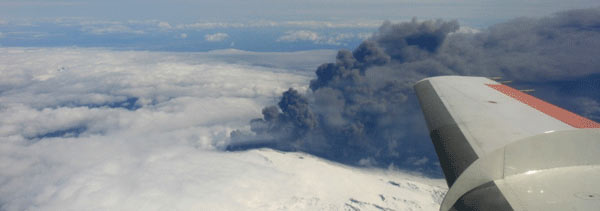Size of Ash from Icelandic Volcano Stuns Scientists


In April, when the volcano Eyjafjallajokull erupted in Iceland, spewing clouds of thick ash across the sky and disrupting global travel patterns, scientists hundreds of miles away in Germany were standing by, ready to study the plume.
"The blue skies were gone. We had very gray skies, and it was all ash," said Albert Ansmann, deputy department head of physics at the Leibniz Institute for Tropospheric Research in Leipzig, Germany.
Ansmann and his research team measured one of the largest ash plumes recorded over Germany and were surprised to find that some of the volcanic ash particles were larger than many scientists had thought possible.
Most atmospheric models had predicted ash particles with diameters larger than 10 micrometers would be too heavy to stay in the sky, and would simply fall down to Earth within 500 miles (800 kilometers) of their point of origin — in this case, the volcano mouth in southern Iceland. However, the team reported finding a significant amount of particles exceeding 20 micrometers over Germany, some 1,500 miles (2,400 km) away.
The team also found that the ash plume blocked an extraordinary amount of sunlight. Measurements indicated that 50 percent to 80 percent of incoming sunlight was scattered by the plume, Ansmann said, although he added that much of that sunlight would have been scattered toward Earth, so that the actual reduction of sunlight below the ash layer was probably closer to 10 percent to 25 percent.
Nevertheless, compared to measurements taken in Italy of volcanic eruptions there, the Eyjafjallajokull ash plume blocked around three times as much sunlight in Germany, despite being so far from the eruption, said Ansmann.
"In the case of Eyjafjallajokull we were more than 2,500 kilometers away," or 1,550 miles, so the reductions in sunlight were "really huge," he told OurAmazingPlanet.
Get the world’s most fascinating discoveries delivered straight to your inbox.
The measurement of the plume and how it moved at various altitudes also helped confirm climate change models that take into account the transport of aerosols (tiny suspended particles) in the atmosphere.
"This is an exciting example for atmospheric modeling to prove that the models work well," Ansmann said.
Scientists use models to study the dispersion of aerosols in the atmosphere and to predict how emissions affect Earth's climate. In their predictions, modelers consider dust over the Sahara, smoke from large fires, and theoretical calculations; having a real measurement as an example lends strength to the models' predictions, Ansmann said.
The team's results were detailed in the July 15 issue of the journal Geophysical Research Letters.
This article was provided by OurAmazingPlanet, a sister site to LiveScience.


